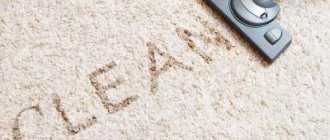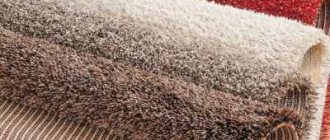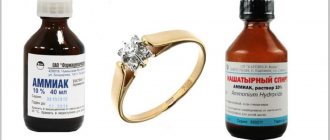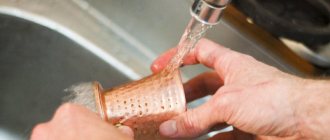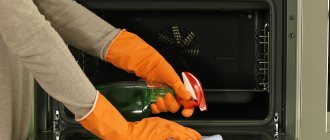Kitchen utensils made of stainless steel look stylish, they are easy to use and have a long service life, but such products are susceptible to various types of contamination: carbon deposits, plaque, soot, and corrosion. This raises a reasonable question: how to clean stainless steel at home quickly and effectively?
Stainless steel is used to produce beautiful and functional cookware. To preserve the external and operational properties of the products, and prevent the pots from darkening, provide them with proper care.
Available folk remedies or household chemicals will help you wash steel and restore its shine and shine. In this article we have collected useful tips and effective methods for cleaning stainless steel.
How can you remove rust from a bicycle?
What to do:
- Treat rust stains with a brush or scraper.
- Degrease the surface with a soda solution.
- Rinse the surface with water to remove the baking soda.
- Soak the swab in acid.
- Wipe the affected areas.
- Neutralize the acid with soda solution.
- Wash it all off with water.
- Dry your bike.
30 Jan
2022 Interesting materials:
How to switch laptop to TV? How to switch laptop to second screen? How to switch from Russian to English on a laptop? How to reassign buttons on a laptop keyboard? How to reassign the fn button on a laptop? How to transfer data from one computer to a laptop? How to transfer photos from phone to laptop? How to transfer an image from iPhone to laptop? How to reinstall the video card driver on a laptop? How to reinstall the system on a Lenovo laptop?
Causes of corrosion
The reasons for the oxidation of stainless steel can be:
Low quality material. If there are too many impurities in steel, it will be more susceptible to corrosion than high-quality material.
Damage. Rust may appear if the metal has been subjected to heat treatment or mechanical damage. For example, steel can rust at welds, scratches and chips, as well as other damage leading to its deformation.
Environment of use. If parts or objects are used in aggressive environments, they may also rust due to instability to external conditions. In this case, you need to use stainless steel items, for example, with increased corrosion protection.
Preventing corrosion on stainless steel
Well, we have cleaned up the corrosion, our steel is now like new. But what can be done to prevent contamination from happening again? For this, there are such means as: rust converter , anti-corrosion compounds and many other chemicals, the names of which speak for themselves. After application, they create a protective film that prevents further corrosion.
There are different types of chemical coatings for different types of metal and stainless steel. After application, objects can be coated with varnish or paint.
Anti-scale agents
Scale is a limescale deposit that appears when using hard water. The calcium carbonate in the liquid reacts with the metal, eventually forming a dense whitish layer. When boiling, mineral ingredients in the form of flakes settle to the bottom of the pan. A thin, sloppy coating appears on chrome surfaces of radiators, household appliances and furniture.
An acidic solution (lemon, vinegar) will help get rid of limescale deposits inside kitchen utensils. The liquid in the problem container is brought to 100 C, then boiled over low heat and left to cool for an hour. After time, the moisture is removed and the dishes are rinsed.
Removing plaque from the sink Source zen.yandex.com
An acidic environment will help remove a thin layer of limescale on a chrome tap, heated towel rail or furniture elements. The warm solution is distributed using a spray bottle or applied with a sponge. The procedure is repeated every 15 minutes. After an hour, wipe the surfaces with a damp cloth.
Heavy limescale deposits in a kettle or pan can be removed with Coca-Cola. Add 50% of the carbonated drink to the kitchen utensils and slowly bring to a boil. The scale is scrubbed off after 30 minutes with a regular sponge.
Home remedies for cleaning stainless steel cutlery
The simplest product for cleaning stainless steel is dishwashing gel . Wash spoons and forks thoroughly using a soft foam sponge and the selected preparation. After cleaning, rinse the appliances under running water and wipe dry so that no white streaks remain.
A simple and effective method for cleaning cutlery is boiling. Place the products in a large container, fill with hot water and put on fire. Boil for 20-40 minutes, then rinse in clean water and wipe
Other cleaning methods:
- toothpaste or toothpaste to a cloth and rub it over all forks, spoons and knives. Rinse items under running water and dry on a towel.
- Prepare a liquid solution based on water and mustard powder . Soak a sponge in the liquid and treat all products.
- To get rid of dark tea stains, soak in vinegar and wipe the utensils. To remove stubborn stains, soak the items in a vinegar solution for 10-20 minutes.
- ash will help clean cutlery outdoors .
Store cleaned stainless steel cutlery in special compartments, away from moisture, dust and other sources of contamination.
Removing plaque from the sink with detergents
Stainless steel sinks are coated with a protective film of chromium oxide, which prevents corrosion and tarnishing of the metal. However, the integrity of this layer is damaged under the influence of food fats and dyes. The admixture of lime in the water forms a coating on the walls.
To increase the service life of the sink, you need to clean the surface in a timely manner. Depending on the level of contamination, stainless steel can be treated with mild detergents or traditional methods can be used.
The option using Anti-grease is suitable for removing minor stains and daily preventive maintenance of the protective layer of the sink. For the procedure you will need:
- dishwashing gel;
- nylon washcloth;
- glass cleaner;
- towel.
After each use of the sink, it is enough to apply a few drops of the gel on a nylon sponge and wipe the surface from grease, and remove excess soap suds with a damp cloth. Such prevention will prevent serious contamination and the formation of limestone.
To achieve the initial shine, the surface of the sink should be sprayed with glass cleaner. For ease of application and handling, use a microfiber cloth, then wipe everything with a dry towel.
Stainless steel is sensitive to abrasive materials. Steel wool or stiff brushes can leave scratches that only a professional can remove.
If the stains do not respond to a soft washcloth and detergent, then another way is needed in the fight against dark stains and limescale.
What is prohibited to use?
To avoid damaging the integrity of the stainless steel sink surface and leaving a number of unsightly scratches on it, you should not use abrasive substances. Metal brushes will damage the structure and scratch the stainless steel coating. Products containing ammonia can leave dark oxidized traces. You should also exclude whiteness, and if you still cannot do without it, monitor the time of its interaction with the stainless coating. The product should be washed off immediately after immediate cleaning.
How to rub stainless steel to make it shine?
One of the easiest ways to remove stains on stainless steel from water drops and fingers is window cleaner. It is sprayed onto the surface and wiped with a dry soft cloth. Then they are washed, wiped again and additionally polished with a dry soft towel.
Interesting materials:
How to find out the date of registration in government services? How to find out date of birth in Apple ID? How to find out the debt from the judiciary? How to find out if there is deportation to Russia? How to find out if you have an electronic sick leave? How to find out if there is shim in the monitor? How do you know if there is a draft? How to find out if you have alimony? How to find out if the bailiffs have a debt? How to find out the IP address of a network folder?
Main stages of working at home
Removing the grille
- make sure that the structural element is cooled down and remove it from the slab;
- place the grates in the sink and rinse off the surface layer of dirt with hot water;
- to speed up the process of fat removal, apply any abrasive detergent - the product is made of wear-resistant materials, so you don’t have to worry about scratching it;
- leave the grates for a while and proceed to the next step.
Processing
- spray or spread the selected product with a sponge on all open areas of the kitchen appliance, treat areas with stubborn stains with special care, but under no circumstances try to scrub them off - let them soak thoroughly in the cleaning solution and then it will be much easier and safer to remove them;
- While the cleaning agent remains “working” on the stove, return to the grates: treat all parts of the structural element in its upper and lower planes with an abrasive agent, rinse and dry.
- wash the stove without effort, with light movements;
- if there are stains or food residues on its surface, reapply the cleaning agent and wait a little longer;
- After this, remove the stubborn dirt and preparation with a sponge, treat it several times with a sponge soaked in water.
Wipe dry and collect
Use a soft cloth or towel to dry the stove while polishing it. Replace the burners and grill.
Preventative measures
To avoid problems and make the cleaning process easier, you need to remember about prevention.
- Do not use products that contain abrasive particles. Powdery substances will cause small scratches on the sink where dirt and bacteria will accumulate.
- Do not leave food waste on the sink. As soon as you wash the dishes, immediately clean the drain of any remaining food, otherwise new stains will form and eat into the surface.
- Do not use metal brushes. These devices cause defects.
- Polish regularly. The sink should maintain a shiny appearance, so it needs to be treated with vegetable or olive oil 2 times a month.
- Do not leave dirty dishes in the sink for a long time. Because of them, an unpleasant odor, plaque, and rust will appear.
Thanks to the above steps, you can keep your kitchen sink looking flawless and avoid serious problems.
Precautions and basic washing rules
- Before washing a stainless steel stove, make sure it is not in working condition and be sure to disconnect the appliance from the gas or electrical supply. During the cleaning process, you may accidentally turn on the equipment.
- Remove all dishes and other items from the hob so that detergent does not come into contact with them.
- If the stove is gas, remove the grate and burners. Disconnect the heating control knobs from the main structure.
To prevent stains on the surface of the device or the formation of toxic gas, do not use several chemicals at the same time .
If you bought a new product designed to care for a stainless steel product, test its effect on an area that is not visible to the naked eye.
To avoid an allergic reaction to the components of cleaning products, carry out cleaning only with rubber gloves.
Rules for washing slabs:
- The use of abrasive substances in the care of stainless steel surfaces is not allowed - even the smallest particles will leave micro-scratches on the plate, and over time this will lead to rusting of the metal;
- Detergents should not contain chlorine - the presence of the substance contributes to the appearance of white spots, which are very difficult to remove;
- After each cooking, wipe the stove with any dishwashing liquid while it is still warm - this method will effectively remove all dirt.
ATTENTION! There are a large number of special cleaning compounds for steel kitchen products, so before purchasing a new product, carefully read the information provided in the instructions for it.
Useful video on the topic
Despite the fact that this type of metal is quite durable, cleaning a stainless steel sink is not so easy. Since the material is very capricious, it requires daily care. Regular cleaning will help prevent the accumulation of fats and dirt, which are the culprits of the specific aroma and the appearance of various bacteria on the walls of the sink. In order not to spend a lot of time on cleaning, every housewife should know which products to use that will help achieve quick and effective results.
Polishing with chemicals
This method is most often used when you need to clean small items. The main thing is that polishing takes little time and is very simple to do. Below are several recipes for solutions.
Recipe 1
It is important to maintain proportions here. Contains: 230 ml sulfuric acid, 70 ml hydrochloric acid, and 40 ml nitric acid
The rest is water.
For one liter of solution you need another 5 g of sodium chloride, 5 g of acid black dye and 10 grams of wood glue.
The resulting liquid must be heated to 70 degrees Celsius and the part must be lowered there. The product can be left in the solution for a maximum of half an hour.
Recipe 2
You will need orthophosphoric acid, it should make up 20-30 percent of the total volume. Hydrochloric acid (3-4%), nitric acid (4-5%), methyl orange (1%). The rest is water. The solution should be at room temperature, and keep the product in it for no longer than 10 minutes.
Recipe 3
The acid content is indicated per liter of solution. Acid orange dye - 25 g, sulfuric acid - 230 g, hydrochloric acid - 660 g. Heat the liquid to seventy degrees and keep the metal in it for no more than three minutes.
Polishing rules are given below:
- The metal must be thoroughly cleaned before polishing. Next, place the product in the solution. It should be remembered that only distilled water can be used here.
- During the procedure, the solution must be constantly stirred, only in this case the chemical reaction will take place 100%.
- When the required time has passed, the part is removed and washed well with running water. After this, the product must be well rubbed with a napkin soaked in polish.
After this treatment, all roughness is eliminated.
It is not enough to polish stainless steel correctly; it also needs to be cleaned regularly.
Secrets of care
Caring for stainless steel cookware is easy. There are three rules that must be followed during operation.
Regular cleansing
After finishing cooking, do not delay in washing pots and saucepans. Dried traces of food on the walls are much more difficult to wash off than fresh ones.
Difficult stains need to be soaked. Scrub using special sponges and gels.
Delicate wash
It is better not to use cleaning products containing abrasive and aggressive substances. The use of soft gels extends the life of dishes.
Perfect dryness
Do not put a wet pan in the cupboard. After each wash, you need to wipe it dry with a towel. If you follow this rule, there will never be streaks on the bottom and walls.
Effective Ways to Clean Steel Pans
Stainless steel pans are susceptible to various stains, but burnt food and persistent greasy deposits are more common. Home remedies will help you wipe off stains quickly and easily.
Steel pans are in demand among housewives because they are easy to use and care for, and they look stylish and beautiful. To extend their service life, maintain shine and cleanliness, carry out preventive cleaning
Lemon juice
Lemon juice will help remove grease from the pan:
- In a container, mix 1 tbsp. l. juice and 1 glass of water.
- Dampen a soft sponge in the solution and treat all surfaces with it.
- Rinse away any remaining dirt with running water.
- Wipe the pan dry with a soft cloth. To add shine, polish it with a piece of flannel.
Coffee
Aromatic coffee will help get rid of burnt and greasy stains. Apply a small amount of ground coffee powder to a damp sponge and gently scrub the stained areas. After removing stains, rinse the pan with clean water and dry naturally.
After cleaning stainless steel kitchen utensils, wash them well with dishwashing detergent and then with clean water. This is guaranteed to get rid of plaque and return the surface clean and shiny.
Activated carbon
The following method will help you cope with the remains of burnt food:
- Fill the bottom of a still warm container with crushed activated carbon or table salt so that the product covers the dirt.
- Leave the pan for 30 minutes.
- Wash the container with a sponge using dishwashing detergent, and then rinse with a solution of lemon juice.
To make the pan shine and shine, after cleaning, wipe the surface with a cloth moistened with a solution of ammonia (1 drop per 1 liter of water). This method is applicable not only for dishes, but also for any stainless steel surfaces - hood, kettle, stove or sink.
How to clean a stainless steel hood and sink
The following products and methods are suitable for cleaning a hood or kitchen sink:
- Use special medications. Before using household chemicals, read the instructions and follow the recommendations.
- Wash the surface with a solution made from lemon juice and water.
- Apply vinegar to a soft cloth and wipe all surfaces thoroughly. Wash the hood or sink with clean water and then wipe dry.
- Combine baking soda and mustard powder in equal proportions. Apply the mixture to the stainless steel with a sponge and rub well to remove dirt.
- Peel the potatoes, cut them in half and grate all surfaces. This method will return shine and shine to steel objects.
Household chemicals will help restore the cleanliness and shine of your stainless steel sink. When working with them, follow the instructions, and after cleaning, rinse the surface thoroughly
Traditional methods for removing plaque and stains from the sink
When a regular washing gel cannot cope with stains, you can use improvised means that you can always find at home or in the store. If you don't clean your sink daily, you'll end up dealing with dark stains, limescale, and greasy residue. Using folk recipes will help clean your sink and prevent serious contamination.
Removing black stains from a stainless steel sink
No matter how well the surface of the sink is cared for, over time the metal begins to darken and black spots appear on it. It's all about food oxidizing agents.


